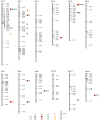Fine Mapping of Five Grain Size QTLs Which Affect Grain Yield and Quality in Rice
- PMID: 38673733
- PMCID: PMC11050437
- DOI: 10.3390/ijms25084149
Fine Mapping of Five Grain Size QTLs Which Affect Grain Yield and Quality in Rice
Abstract
Grain size is a quantitative trait with a complex genetic mechanism, characterized by the combination of grain length (GL), grain width (GW), length to width ration (LWR), and grain thickness (GT). In this study, we conducted quantitative trait loci (QTL) analysis to investigate the genetic basis of grain size using BC1F2 and BC1F2:3 populations derived from two indica lines, Guangzhan 63-4S (GZ63-4S) and TGMS29 (core germplasm number W240). A total of twenty-four QTLs for grain size were identified, among which, three QTLs (qGW1, qGW7, and qGW12) controlling GL and two QTLs (qGW5 and qGL9) controlling GW were validated and subsequently fine mapped to regions ranging from 128 kb to 624 kb. Scanning electron microscopic (SEM) analysis and expression analysis revealed that qGW7 influences cell expansion, while qGL9 affects cell division. Conversely, qGW1, qGW5, and qGW12 promoted both cell division and expansion. Furthermore, negative correlations were observed between grain yield and quality for both qGW7 and qGW12. Nevertheless, qGW5 exhibited the potential to enhance quality without compromising yield. Importantly, we identified two promising QTLs, qGW1 and qGL9, which simultaneously improved both grain yield and quality. In summary, our results laid the foundation for cloning these five QTLs and provided valuable resources for breeding rice varieties with high yield and superior quality.
Keywords: QTL; grain size; quality; rice; yield.
Conflict of interest statement
The authors declare no conflicts of interest.
Figures









Similar articles
-
Identification of a novel locus qGW12/OsPUB23 regulating grain shape and weight in rice (Oryza sativa L.).Theor Appl Genet. 2024 Nov 14;137(12):267. doi: 10.1007/s00122-024-04776-w. Theor Appl Genet. 2024. PMID: 39540992
-
Genetic dissection of rice grain shape using a recombinant inbred line population derived from two contrasting parents and fine mapping a pleiotropic quantitative trait locus qGL7.BMC Genet. 2010 Feb 26;11:16. doi: 10.1186/1471-2156-11-16. BMC Genet. 2010. PMID: 20184774 Free PMC article.
-
Candidate gene analysis of rice grain shape based on genome-wide association study.Theor Appl Genet. 2024 Sep 29;137(10):241. doi: 10.1007/s00122-024-04724-8. Theor Appl Genet. 2024. PMID: 39342533
-
QTL analysis of novel genomic regions associated with yield and yield related traits in new plant type based recombinant inbred lines of rice (Oryza sativa L.).BMC Plant Biol. 2012 Aug 9;12:137. doi: 10.1186/1471-2229-12-137. BMC Plant Biol. 2012. PMID: 22876968 Free PMC article.
-
Grain Size Associated Genes and the Molecular Regulatory Mechanism in Rice.Int J Mol Sci. 2022 Mar 15;23(6):3169. doi: 10.3390/ijms23063169. Int J Mol Sci. 2022. PMID: 35328589 Free PMC article. Review.
Cited by
-
Deciphering the genetic basis of agronomic, yield, and nutritional traits in rice (Oryza sativa L.) using a saturated GBS-based SNP linkage map.Sci Rep. 2024 Aug 4;14(1):18024. doi: 10.1038/s41598-024-67543-3. Sci Rep. 2024. PMID: 39098874 Free PMC article.
-
QTL detection for grain shape and fine mapping of two novel locus qGL4 and qGL6 in rice.Mol Breed. 2024 Sep 15;44(9):62. doi: 10.1007/s11032-024-01502-8. eCollection 2024 Sep. Mol Breed. 2024. PMID: 39290202
References
-
- Zhao F., Zhang G., Yang Z., He G. Pyramiding QTL for yield-related traits and grain shape in rice using single-segment substitution lines. Indian J. Genet. Pl. Br. 2014;74:496–498. doi: 10.5958/0975-6906.2014.00875.X. - DOI
MeSH terms
LinkOut - more resources
Full Text Sources
Miscellaneous

